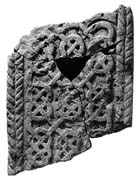Select a site alphabetically from the choices shown in the box below. Alternatively, browse sculptural examples using the Forward/Back buttons.
Chapters for this volume, along with copies of original in-text images, are available here.
Object type: Incomplete grave-cover, in seven fragments now joined
Measurements: L. 66 cm (26 in) W. 50 > 49 cm (19.5 > 19.25 in) D. 12 cm (4.75 in)
Stone type: Pale brown to yellow calcareous siltstone or fine sandstone with scattered ooliths, some clustered in patches; cf. Lincoln St Mark 5 and 17. Greetwell Member, Lower Lincolnshire Limestone of Lincoln vicinity, Inferior Oolite Group
Plate numbers in printed volume: Fig. 14; Ill. 241
Corpus volume reference: Vol 5 p. 200-201
(There may be more views or larger images available for this item. Click on the thumbnail image to view.)
Seven conjoining fragments from the central part, towards its head end, of a flat slightly tapering grave-cover of Lindsey type, decorated in low relief and only on the upper surface.
A (top): The border is defined by a twin cable moulding in a herringbone pattern and the central panel is occupied by three interconnecting lines of simple pattern F interlace, which produce a repetitive figure-of-eight pattern in three surviving rows. The figure-of-eight units measure 16.5 × 10 cm (6.5 × 4 in): the layout and spacing of the lines and rows is reasonably regular but not perfect. At the head end, the pattern terminates against a reserved area scalloped by the completion of the pattern and with a lightly incised border moulding. The decoration stands sharply as a squared U section against a flat cut-away background.
B and D (long): Undecorated, but worked into a bowed section.
C and E (ends): Irregularly broken.
F (bottom): Dressed to an original surface.
This is one of the interlace covers of Lindsey type discussed in Chapter V. It belongs to the sub-group (a) distinguished by their double cable or herringbone border (Table 6). The creation of a reserved area at the end of the pattern as a deliberate device finds a direct analogy at Miningsby (Ill. 301), except for the additional incised decoration. Since the norm on these covers is for the herringbone to point to the foot, the reserved area lay at the head on both covers and may not necessarily have been repeated at the foot as conjectured by Stocker's reconstruction (1986a, fig. 53).



